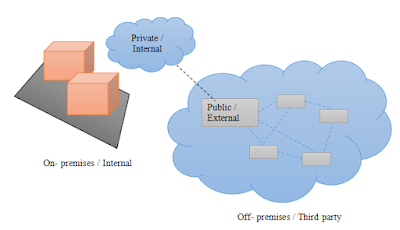Define cloud computing. What are the different types or deployment models of cloud ?
- Cloud computing is the model for enabling, convenient, on-demand network access to shared the pool of configurable computing resources.
- Basically it is the collection of integrated and network hardware, software and internet infrastructure.
- It uses the internet for communication and transport hardware, software and network services to the client.
- In addition, the platform provide the on-demand services that are always available anywhere to the client.
- For example if you store your photos online instead of on your home computer or use web-mail or social networking sites, at that time you are using cloud service.
- Cloud computing refers to the delivery of resources over the internet.
- Instead of keeping the data in your pwn hard disk or updating the application for your own need, you used service over the internet called cloud service.
- Cloud service allow the individual or business to used software and hardware that are managed by the third parties at remote location.
- The example of cloud service include online file storage, social networking sites, web mail and online business applications.
- The cloud computing model allows to access information anywhere that the network connection is available.
- If we take the architecture of cloud computing, it may involve deployment model, service model and essential characteristics.
Different types or deployment models of cloud :
There are mainly four types or deployment model of cloud as follows
i) Public cloud
ii) Private cloud
iii) Hybrid cloud
iv) Community cloud
i) Public cloud
These cloud infrastructure is made available to the general public or large industrial group. Public cloud is also known as external cloud. In public cloud, service provider makes resources, such as application, storage etc. available to the general public. The public cloud is hosted, opened and managed by third party vendor from one or more data center.
The main benefits of using public cloud is that it provide easy and inexpensive setup of hardware, application and bandwidths costs are covered by provider. Also in public cloud there is no wasted resources, as you pay for what you use. Example of public cloud include amazon elastic computer cloud (EC2), sun cloud, google app engine etc.
ii) Private cloud
Private cloud is also known as internal cloud. These cloud infrastructure is operate solely for a single organization managed by that organization or third party. Private cloud provide hosted service to the limited number of people behind a firewall. Most of organization wants more control on their data that they can get by using third party hosted service such as amazon elastic computer cloud.
iii) Community cloud
These cloud infrastructure is shared by several organization and support for specific community. It may be managed by organization or third party and may exists on- premises or off-premises. A community cloud may be private for its stakeholders or may be hybrid that integrates the respective private cloud.
iv) Hybrid cloud
Hybrid cloud infrastructure is composition of two or more clouds (private, community or public) bounded together by standardized technology. In hybrid cloud mainly at least one public cloud and one private cloud is essential, as public cloud form a partnership with public cloud provider or private cloud forms a partnership with public cloud provider.
Characteristics :
1) On-demand self service
User can provide computing capabilities such as server time and network storage as needed automatically without requiring the interaction with each service provider.
2) Broad network access
Cloud may have broad network access mechanism, so that client can access it at anytime and anywhere over the network. Client may access through its mobile phones, laptops, tablets and workstations.
3) Resource polling
The providers computing resources are polled to serve multiple users adopting to multiple model, with different physical and virtual resources.
4) Rapid elasticity
capabilities can be elastically provisioned and released. In some cases, to scale rapidly and automatically inwards and outwards depending on demand.
5) Maintenance
Easy to maintain, as no need to install it on each individuals users computer. It can be access from multiple location.
6) Security
Most important characteristics as cloud provider can often allocated resources to security efforts that users and companies simply cannot afford themselves.
These cloud infrastructure is shared by several organization and support for specific community. It may be managed by organization or third party and may exists on- premises or off-premises. A community cloud may be private for its stakeholders or may be hybrid that integrates the respective private cloud.
iv) Hybrid cloud
Hybrid cloud infrastructure is composition of two or more clouds (private, community or public) bounded together by standardized technology. In hybrid cloud mainly at least one public cloud and one private cloud is essential, as public cloud form a partnership with public cloud provider or private cloud forms a partnership with public cloud provider.
Characteristics :
1) On-demand self service
User can provide computing capabilities such as server time and network storage as needed automatically without requiring the interaction with each service provider.
2) Broad network access
Cloud may have broad network access mechanism, so that client can access it at anytime and anywhere over the network. Client may access through its mobile phones, laptops, tablets and workstations.
3) Resource polling
The providers computing resources are polled to serve multiple users adopting to multiple model, with different physical and virtual resources.
4) Rapid elasticity
capabilities can be elastically provisioned and released. In some cases, to scale rapidly and automatically inwards and outwards depending on demand.
5) Maintenance
Easy to maintain, as no need to install it on each individuals users computer. It can be access from multiple location.
6) Security
Most important characteristics as cloud provider can often allocated resources to security efforts that users and companies simply cannot afford themselves.








Comments
Post a Comment